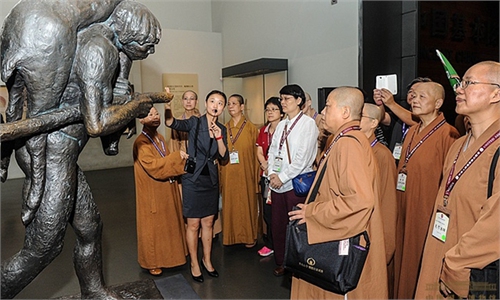ARTS / CULTURE & LEISURE
Introducing US students to Chinese life

Illustration: Chen Xia/Global Times
During the 30th APEC Economic Leaders' Meeting in San Francisco, President Xi Jinping announced that China was prepared to host 50,000 students from the US for exchange and study abroad programs. In response to this invitation, the Beijing No. 4 High School International Campus (BHSFIC) has welcomed exchange students from the Vaughn Next Century Learning Center ("Vaughn") to China for a mutual learning experience.
Vaughn is a large urban public school within the Los Angeles Unified School District (LAUSD). Despite being located in a community where low student achievement is common, Vaughn has been a beacon of hope and change. The school has made a significant impact on the lives of many low-income students, who have faced challenges such as relying on free or reduced lunch, experiencing homelessness, and navigating the difficulties of being first-generation high school and college students. Study abroad programs like these have provided students with the opportunity to broaden their understanding of global dynamics and cultivate global citizenship.
Over the weekend, students and teachers from Vaughn arrived in Beijing to kick off a new wave of China-US cultural exchange programs. They visited the Temple of Heaven, the Forbidden City, and the Great Wall, where they marveled at the traditional Chinese architecture and learned about the country's cultural heritage. The students particularly enjoyed the stories shared by their tour guide at the Forbidden City, such as those about emperors, empresses, and concubines, and found it fascinating to see how different cultures influence storytelling and cultural legacies.
From Tuesday to Thursday, the exchange students from Vaughn will be shadowing host students like myself from BHSFIC, attending classes, participating in extracurricular activities, and immersing themselves in the authentic lives of Beijingers.
On Tuesday, at 7:30 am, the exchange students gathered for a welcoming ceremony. As they entered the room, I noticed the bright red scarves embroidered with a gold character fu, meaning good fortune, that all of the students were wearing. These scarves were gifts from counselors they met in Los Angeles. This act of respect of Chinese culture was only a prelude to their willingness to embrace cultural diversity, heritage, and different cultural experiences throughout the day.
Both Principal Li Shuming from BHSFIC and Principal Yvonne Chan from Vaughn Next Century Learning Center emphasized the importance of open-mindedness and the significance of this program. Hosting students from the US provides an opportunity for mutual learning and growth, they emphasized. What I found special about the cultural exchange was the way Principal Chan, who grew up in China and pursued her educational career in the US, spoke to students from both schools through her intercultural experience.
She described this exchange as a culmination of the Chinese Dream and the American Dream. The establishment of close connections between youngsters immersed in drastically different cultural backgrounds and experiences is a microcosm of the China-US collaboration. The understanding and connections that started in that very room transcends beyond geography or political borders and points to the hope and peace that is possible between the two nations.
The exchange students later joined me and my fellow host students in our classes to experience what a day in the life of a Chinese student looks like. For example, four exchange students joined our Pre-AP Seminar course in the morning, where we discussed the concept of love. One of the four, Jayden Josiah Recinos, said that the Pre-AP Seminar course was the most memorable, not only because the course was not offered at their school, but also because of the engagement of every single student within the class. The freedom of discussing general themes that all students could relate to brought the content to life; it was drastically different from the writing, lecture, and discussion in their English class back home, he said.
Another student, Michael Sosa Lezama, also appreciated the philosophical approach of the Pre-AP Seminar course. "The classroom was just open to every student who wanted to participate," he reflected. He was surprised by the difference from his expectations of what school in Beijing would be like. He contrasted his experience in a Chinese class in Los Angeles, where there was no room for talking and discussion, with the engaging environment at BHSFIC, which pleasantly surprised him.
Other students took courses such as Chinese, Chemistry, and Physics.Mariana Ruvalcaba, who I hosted, joined me in my physics and chemistry courses during the school day. She stated that while she did not completely understand the content, she liked the structure of the lectures. What I found the most surprising was her appreciation of the freedom given to the students in my classes. In physics and chemistry, "students could pace their learning to their own preferences," she commented. "I feel like in US schools, especially my school, teachers are also there to supervise more so than to teach." She showed me a different view of our classes and helped me acknowledge the plethora of opportunities and privileges that BHSFIC bestows on its students.
The presence of exchange students in our classrooms provided me with a fresh perspective on what I considered "normal." They promoted greater multicultural awareness and encouraged me to reflect on the unique aspects of my own upbringing in Beijing. Their integration into our classes and their eagerness to share their observations about the differences between our lives and theirs back home illustrated the potential for intercultural unity, as long as we continue to create opportunities for communication and understanding.
The author is a student at Beijing No. 4 High School International Campus. life@globaltimes.com.cn



